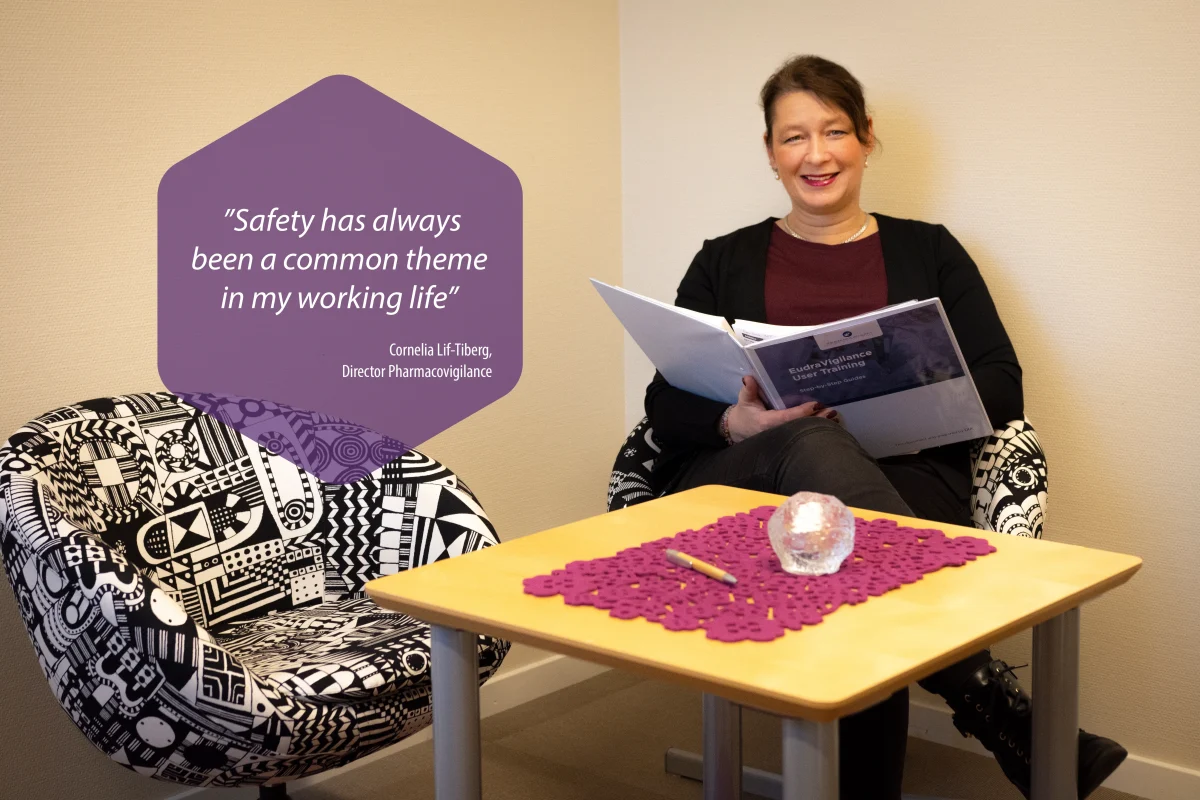
Pharmacovigilance, drug safety surveillance
All drugs can cause adverse reactions. Pharmacovigilance means the collection, evaluation, surveillance and reporting of those. The Pharmacovigilance department at CTC can perform qualified safety surveillance during the whole drug development process.
When a drug is tested in human for the first time, all adverse events are unexpected and it’s essential to pick up signals indicating a safety risk for the patient.
“On behalf of the sponsor, I monitor overall patient safety in the study and can assist in many ways, for example by being the sponsor’s medical monitor, by following the safety profile of the drug and by informing other sites if suspected, unexpected, serious adverse reactions (SUSARs) occur”, says Cornelia Lif-Tiberg, Director Pharmacovigilance at CTC Clinical Trial Consultants.
Medical monitoring during a clinical trial means safety surveillance with continuous, formal, medical evaluation of adverse events. By being involved from the start of study design to the study end and via a close partnership with investigators, sponsor, medical writer and monitors, the medical monitor gains a fundamental safety perspective on the medical investigational product and the clinical trial. For this, it’s essential to have experience in clinical trials, as well as a medical license and an education in safety reporting.
Since 2010, Cornelia Lif-Tiberg has been principal investigator in approximately 50 clinical trials, including several first-in-human trials. Before that, she worked as an anaesthesiologist and intensive care physician for 15 years. She has worked at pharmaceutical companies, CROs and at the Poison Information Centre at the Medical Product Agency.
“Safety has always been a common theme in my working life. When I worked with anaesthesia and intensive care I met lots of patients with different diagnoses using various drugs, requiring me to predict risks, to be observant and to act when unexpected side effects showed up. As a medical monitor, I oversee the drug’s safety and predict what adverse events that could be expected in the different organ systems. This requires both a profound medical expertise and clinical trial experience.”
Cornelia Lif-Tiberg can also organise, or participate in, a Data Monitoring Committee (DMC) comprising specialised physicians and statistician(s). This DMC can recommend if the study should continue or be terminated, make recommendations about dose levels, propose changes to the study protocol and/or evaluate interim analyses.
In connection to the start-up of a new study, Cornelia Lif-Tiberg always participates in the protocol development process reviewing safety aspects and regulatory requirements.
“I make sure that I am well informed about the drug’s safety profile from the start and I write a safety management plan in due time before the study begins”, she explains.
According to the European Medical Agency (EMA) all SUSARs must be reported into the EudraVigilance database. This is done by the certified Safety Officers at CTC. To be able to report the SUSAR within the short time frames that are required by the regulatory authorities, CTC has a well-defined process that covers unblinding, medical evaluation, medical coding and compilation of the information into a CIOMS form or a corresponding document.
CTC decided to start the Pharmacovigilance department about a year ago to reduce the sponsor´s need for 3rd party vendors in a CTC project. Through our pharmacovigilance service, the sponsor can be given easy access to independent, in-house medical monitoring, from their first-in-human study to the market.
“I enjoy working in a stimulating environment where I can influence people. The department is well separated from the clinic and I become more accessible as a full-time worker instead of being a consultant. It’s very rare that serious adverse events occur in early clinical trials, but when they do happen I have a very short distance to the investigator.”
To work with the same Pharmacovigilance department during the whole clinical development program minimises the risk for delays in the marketing application.
“Since I have experience from both pharmaceutical companies and CROs, I have good knowledge of what’s required from a safety perspective for the drug to move forward. This is why I can recommend what actions that must be taken at an early stage and what can wait until later phases. This creates a close collaboration between authorities, the sponsor and us a CTC.”
